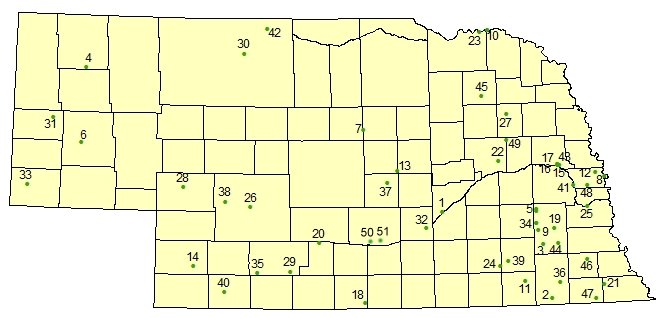
|
NDEQ conducts weekly sampling for Harmful
Algal Blooms (HABs), also known as toxic
blue-green algae, and E.coli bacteria at 50
public recreational lakes across Nebraska
from May through September and these results
are updated weekly. Samples are typically
collected on Monday and posted on the web
site on Friday.
Current Lake(s) on Health Alert.
These lakes exceed the current concentration
threshold of 20 ppb of the toxin Microcystin
which is associated with the presence of
HABs. Lakes that have been placed on
Health Alert
must subsequently have two consecutive weeks
of readings below 20 ppb before the alert is
ended.
20 ppb of microcystin the limit that has
been in effect in Nebraska since 2004, and
will continue to be used through the 2017
recreational season. New research into the
negative health effects of Harmful Algal
Blooms (HABs) and their associated toxins
has led to the Environmental Protection
Agency (EPA) to propose a new threshold
concentration of 4ppb. This proposal is
currently under review before being
finalized. The Nebraska Department of Health
and Human Services and the Nebraska
Department of Environmental Quality has
reviewed the proposal and the associated
research and believes that the new
recommendation has been made using the most
current and best scientific evidence
available. As such, if a recommendation
becomes finalized by the EPA, the State of
Nebraska intends to adopt the new lower
criteria of 4 ppb at the beginning of the
next recreation season.
For more information about health alerts and
what to look for, go to
Precautions and Facts Regarding Toxic Algae at Nebraska Lakes.
Harmful Algal Bloom Facts *
(links to an EPA website)
High E. coli Bacteria Readings, lists lakes
that when sampled had unusually high
readings of E.coli bacteria in the most
recent sampling, which can also be a health
concern. Samples above 235 colonies/ 100 ml
water are considered high.
Click here for more information about bacteria and its potential health effects.
Other Lakes Sampled, lists the results for
lakes which are not under Health Alert for
toxic algae and their most recent sample
results for bacteria are considered low.
Click on any lake name on the table below to
view a chart of that lake’s sample results
for HAB toxin (Microcystin) and E.coli
bacteria for the 2017 recreational season.
Beach Watch Listserv Subscribe information
To subscribe to the listserv, send an email
to listserv@listserv.nebraska.gov with
SUBSCRIBE DEQ-BeachWatch (your name) - in
the body of the message (leave the Subject
line blank).
Example: Subscribe DEQ-BeachWatch John
Smith.
You will receive an email requesting you to
confirm your request. When you confirm by
clicking the link, you will be added to the
listserv .
To unsubscribe, send an email to
listserv@listserv.nebraska.gov In the body
of the message, type SIGNOFF deq-BeachWatch
.
|